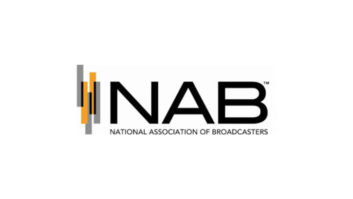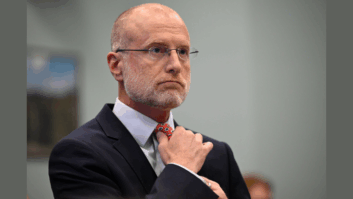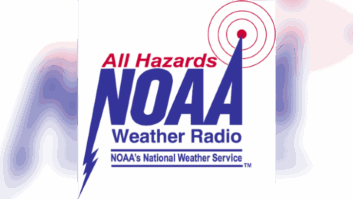Modulate With Care
In the otherwise excellent article “Rebuild That Relic of an AM Transmitter” (Oct. 19), I may have misunderstood the two images of an oscilloscope display that author Mark Persons uses to illustrate asymmetrical modulation in an AM transmitter.
Often such modulation is considered reduced carrier in proportion to the sideband energy, and that’s how I look at a waveform to compare. His example of 125 percent modulation seems to be over-modulation and hitting baseline in the negative direction, a condition that causes splatter and distortion.

100% Modulation. Tubes with good emission give low-distortion results.

125% Modulation. The audio is turned up another2 dB.
Instead, I would have expected to see positive peak energy without hitting baseline covering more vertical gradicules in the asymmetrical example than in the one showing 100 percent modulation.
Paul Courson, WA3VJB
Annapolis, Md.
Mark Persons replies: When testing AM transmitters, I look at the negative and positive modulation capability. Seeing the positive peaks go to 125 percent while achieving a full 100 percent negative is the desirable result of over-modulating the transmitter by 2 dB. That is done by putting a tone directly into the transmitter without any audio processing. Yes, it will cause splatter at that point. Once I know the transmitter can produce high positive modulation, then I know the audio processing can be set to limit to just under 100 percent negative modulation and allow positive peaks to achieve 125 percent modulation with program material. No splatter then and it fully makes FCC requirements.
Corwin: Gemlike Work
Regarding “Radio Great Norman Corwin Dies, Age 101” (Oct. 19):
Corwin’s professional legacy is secure, rooted in the gemlike quality and eternal nature of his body of work; his living legacy lies in the countless lives he touched with his enthusiasm to do better, to improve the small corners of the world we inhabit. He was, and remains, a beacon for those who believe in the power of optimism to nurture the better angels in our daily lives.
Long may he live in our memories and on the Internet.
Vic Cox
Goleta, Calif.
Vic Cox profiled Norman Corwin in Radio World’s Jan. 12, 2011 issue.
First Phones
Kudos to John Schneider and the historical remembrances he brings to the page.
The color picture of the KRLD transmitter, published in the July 1 issue and reproduced on the letters page in the Oct. 19 edition, has a particular pleasing feature for me. I am referring to the pale blue FCC certificates on the wall. First Phones. The way it should be.
Bob Mayben
Broadcast Sales
SCMS Inc.
Gadsden, Ala.
John Schneider replies: I’m glad you liked our “colorized” image; it seems so much more real in color. I tried to reproduce accurately all the known colors and went to some effort to match the FCC blue correctly. The transmitter cabinet color was extracted directly from a color photo of a WE transmitter that I found on the Internet. I had to guess on some of the auxiliary equipment in the racks.
More Like a Performance Wrong
Just read the comments of Maria Pallante (“Copyright Office Still Backs Performance Right,” Radio World NewsBytes, Oct. 26). Here is another government official with no work experience, especially none in broadcasting or even the music industry.
Someone needs to teach her about the role of ASCAP, BMI and SESAC in the daily operations of broadcast stations. She needs to read some of our contracts … and maybe she needs to see how big some of the checks are that broadcasters send to these music owners every month of the year.
And she needs to talk to recording artists and simply ask them what their careers would be like if their songs had never been played on radio, TV or cable. What other industry pays a chunk of its gross income (in our case, 8 percent) to the music industry and then also provides free airtime to promote their products? Cal Zethmayr
General Sales Manager
WAAZ(FM)/WJSB(AM)
Crestview, Fla.
It’s Not Broke So Don’t Fix It
In the Oct. 19 issue, Dan Mason of CBS Radio says he’s concerned about AM radio. Bruce Reese of Hubbard says convert AM to digital and problems go away (“AM’s Future,” News Roundup).
The problem that needs to go away is input from large corporate owners. Every time they buy into some “newfangled” idea, it costs me money, but nothing changes other than my bottom line.
We have a 1 kW AM, analog, gospel and sports programming. None of my listeners complains about not hearing us in digital.
Citadel, Clear Channel and others stay in the bankruptcy line because they buy into every piece of junk that is presented to them. The FCC isn’t much better.
Most of the radio mess is a result of too many worthless 100 kW FMs, the FCC allowing FM/AM combos to be split and sold off, the destruction of local radio by the corporate giants and translators being bought up and held for more profit.
Our station is profitable, sounds good, pleases our community and we have fun.
What needs to happen is simple. No FMs over 25 kW. Every standalone AM gets an FM translator that when assigned is a part of the AM license and can never be sold away from the AM and must simulcast 100 percent of the time.
Our station is in the Baton Rouge market, which like many other markets has way too many radio stations because of corporate ownership. I would like to have a simple 100 watt translator to cover our area at night, but because of corporate manipulation of the FCC, the FM spectrum in Baton Rouge and New Orleans overlaps and there are no FM allotments for anyone. Our people suffer and no one cares.
I pray I live long enough to see the corporate giants finally buy themselves into total bankruptcy and have to divest themselves of about 90 percent of their holdings.
We like serving our little area. Our EAS plan is second to none. Our local governments can activate an EAS and access our transmitter for an unlimited amount of time and not have to listen to some overpaid moronic program director whine. We have been EAS-compliant for months and welcomed the national test. Our local system has been tested and works flawlessly. Our people are safe. There is not one radio station in Baton Rouge or New Orleans that will outshine us in an emergency situation. Katrina, Gustav and tropical storm Lee proved this beyond a shadow of a doubt.
So I say leave us alone to do what we do best: serve in the public interest with our analog signal that works just fine. It’s not broke so don’t try to fix it.
Harry Hoyler
General Manager
KKAY(AM)
Baton Rouge, La.
Free Speech and New Media
This is in response to Craig L. Parshall’s opinion article regarding the John Milton Project (“New Media Has a Free Speech Problem,” Nov. 2).
The right to free speech is a right to speak, not a right to be heard on every media platform you want. If a religious group’s doctrine is so radical that a media platform feels uncomfortable, you should look at the content. Are they propagating sexism, homophobia or racism? In those cases it’s acceptable for them to decline to carry your content.Dismissing this as censorship is arrogant and entitled.
Being stymied by Apple, Facebook et al. is frustrating, no doubt. But it’s the same response you might get from a print publication or from a broadcaster when you bring them questionable content. This is not overt censorship. They are not obligated to taint their brand and/or their product with your hate speech. If you want a media platform that is wide open to troglodyte opinions, build your own, the Internet is a big place. There’s plenty of room.
Jose Fritz
Arcane Radio Trivia
Hoboken, N.J.
No HD Clones
I wish some station owner would put something different on their HD2 stream instead of a “clone” of their HD1 feed. I mean a totally off-the-wall different format to get new listeners to their station and not just siphon off their HD1 listeners because their HD2 feed has such a similar format.
I’m waiting for a reason to show off my HD2 to others, as all three HD2s here are merely offspring of their HD1 hosts at best.
Maybe go so far as to hire some Internet station programming gurus to program your HD2 feed with deep oldies, beautiful music, all comedy, all weather, all-request super-decades, etc. … and in exchange for their programming over your group’s HD2 feeds, they agree to cease their own Internet feeds instead for one branded by your broadcast group and your HD2 OTA status.
If you can’t beat them, join them by hiring them away from their own feeds, including use of their original identifiers on your OTA HD sub-channels and your broadcast site links.
John Pavlica, Jr.
Engineer
Toledo, Ohio







